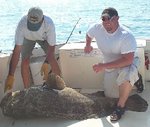Fishing the Florida Keys The Art of Yellowtail Snapper Fishing
Revised 27 November
October and November is a great time to catch large flag Yellowtails, Mutton Snapper and big Black Grouper. This is the time of the year when the Blacks move onto the reef to spawn. So I'll normally get a nice mixed bag of Blacks, Muttons and tails.
Chum fishing is the technique of choice. Count on one 7-pound block per hour of fishing using a medium large mesh bag. I prefer 45 to 60 foot of water with good marked structure this time of the year. Anchor where you have two or more good marks down current of the boat. Start chumming like crazy, shaking the first bag half empty in the first 20 minutes or so. Pre-thawing a block in the cooler the night before helps.
The bait I prefer for the tails is silver side minnows and Ballyhoo strips. Size your bait for you hook. Look at what is coming out of the chum bag, that’s the hatch to match. The rig is simple, tie a size 2 to 2/o hook on the line. The size 2 (or smaller) if the current is light, and use up to the 2/o if the current is running hard. If your bait drifts and drops at the same rate as the chum, you got it right. In a stronger current I'll add a size 7, barrel swivel 2 to 3 feet in front of the hook. Between varying the hook size and swivel combinations, you shouldn't have to add any weight. Light jigs and feathers work but aren't necessary if you get your technique down.
Fresh, clear, 12 to 20 pound monofilament, on a spinning outfit is best for tailing for Flags, yellow tails over 3pounds. Flourocarbon is optional, unless the current is nearly dead and the water is gin clear. If your spot is good, your line fresh and your chum slick kicking, you won't need it. Most people will say twenty is too heavy, until they hook into a 6 plus pound flag way back in the slick, or a 20 pound Mutton.
When you get ready to deploy your bait, give the chum bag a good shake, drop your bait in the chum and start pealing off line fast enough to keep up with the chum cloud and preferably just under the chum in the water. Initial drifts may be three times the water depth or more, but when the bite starts, you should see the fish behind the boat.
While you're tailing, take a few of the live tails and toss them in your bait well. Shoot one of these tails down on a grouper rig with enough weight to keep him from climbing back in the boat. I use larger tails, 14 to 16 inches for grouper baits. I don't like messing around with short grouper. About 6 to 10 foot of leader is recommended for Blacks. Suspend the weight 10 to 20 feet off the bottom to prevent rock ups. Don't go too heavy on the leader; 50 to 80 pound test is plenty.
Keep and eye open for Muttons. If you have a large shrimp, live or fresh dead, you should be able to feed it to them. Smaller Pinfish work as well. A lot of the Muttons you hook will be on the Yellowtail rods. This is why I prefer the slightly larger hook and the 12 to 20 pound test this time of the year.
Yellowtails to 5 pounds, Muttons to 20 pound and Blacks to 50 pounds are common this time of the year, if you have good conditions. Good conditions are an east or west current on the reef, moving with the wind. In the middle keys, the last of the outgoing or first of the incoming tide is best. This is when dirtier water is more likely to be present. Out of Key West, there is less dirty water inflow from the bayside, so any steady current will be just fine.
Come on down and let's catch a few good tasting dinners.
Captain Dallas
Addendum or whatever it is to explain stuff.
The above was written for a time of year I normally hammer bigger fish. I can catch Yellowtail year in and year out. It does get slow at times, but you can still catch these guys. The worst case is no current with gin clear water. You see the fish right there under the boat and they just won't bite. If you see them swimming from left to right behind the boat, they are telling you something. Since they don't have fingers, they are using their fins, get it.
This is the time for the Secret weapon; six-pound leader and size 8 hooks, with very small bits of bait. Look at the fish in water. If you are chumming, somewhere they are eating the chum. Be one with the chum and let your bait be one with you. Anybody can catch fish that are biting, but to catch fish that aren't biting takes finesse. With a slack current watch how the chum drops in the slick and how the baited hook you have drops. If they drop at the same rate, you get a bite. It's presentation, its not hot pink size 6 circle hooks or 167th oz jigs, it's the presentation. Get your baited hook to the same spot the tails are feeding in the slick and you have a fish.
That said visualize what's happening in the slick with a current. At some point, the tails are eating. Vary your weight, (that's add a tiny split shot, switch to a smaller hook, a bigger hook, add a swivel, slow your drift or quicken your drift) whatever, to find the right combination. Once you find the combination, you can hammer the fish.
Sand balling, Oat mixtures, cooked elbow macaroni, are all local favorite chumming additions. I use oats, wet and dry, to kick it up a bit, but plenty of free flowing ground sardines or Menhaden is all it really takes.
Yellowtail snapper will not impress some people, but they are excellent eating, have a good fight for their size and can be a challenge. From what I’ve heard, they kick Lake Erie perches butts big time and the weather is normally a touch nicer in the winter here.
Another Add-on: The new Gulf reef fish regulations require the use of circle hooks, de-hooking devices and venting tools when fish for 'tails in Gulf waters. J hooks are still allowed on the ocean side for now.






No comments:
Post a Comment